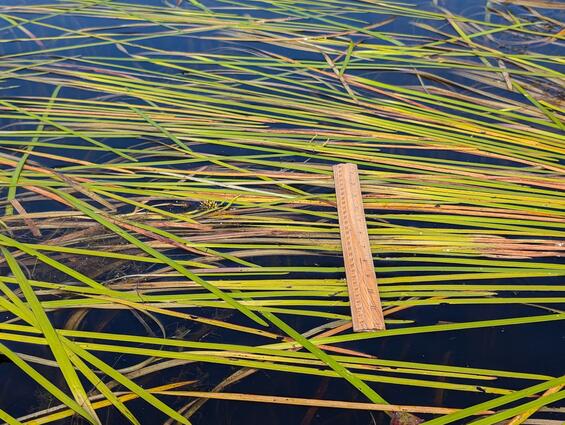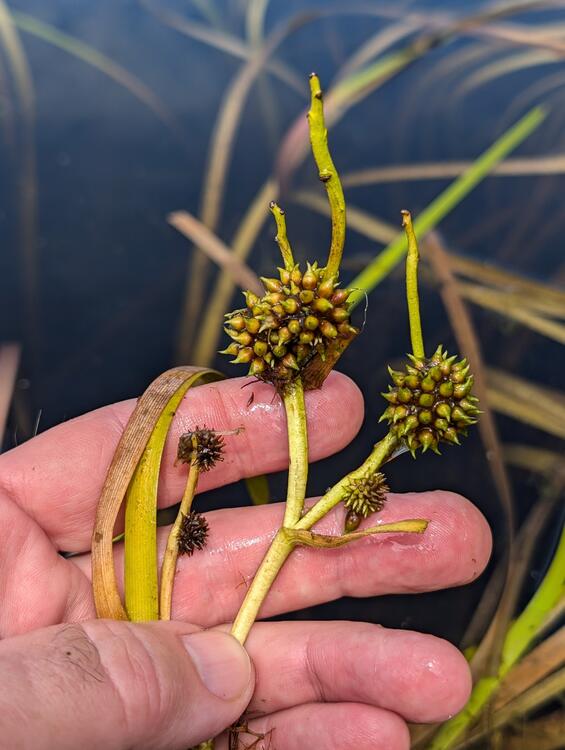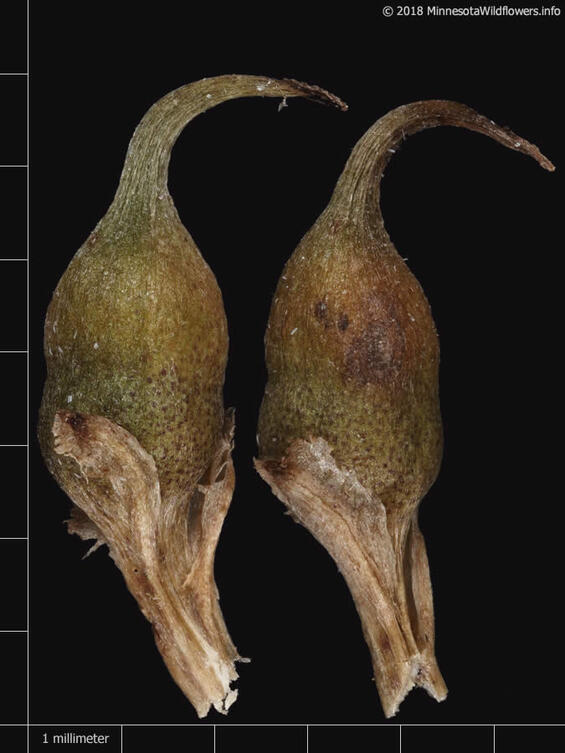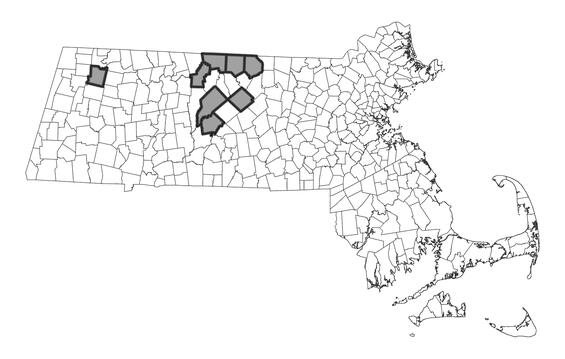- Scientific name: Sparganium fluctuans(Engelm.) B.L. Rob.
Species of Greatest Conservation Need (MA State Wildlife Action Plan)
Description

Leaves floating on pond surface. Image by Robert Wernerehl.
The bur-reeds (genus Sparganium) are a small group of grass-like aquatic and wetland plants of the cat-tail family (Typhaceae); seven species are known from Massachusetts. Unlike true grasses, the leaves lack sheaths and ligules (a characteristic flap of tissue at the base of the leaf blades), and unlike many other aquatic and wetland species with ribbon-like leaves, the leaves of bur-reeds lack a defined mid-vein. Male and female flowers are borne in separate flower heads. Fruits are arranged in dense spherical heads in all bur-reeds.
Floating bur-reed, Sparganium fluctuans, are typically submerged and have flat, flaccid (limp or floppy) leaves. The upper leaves float on the surface of the water. Often only the thin, translucent leaves will be present, and no flowers or fruits will be found. When it does flower, the inflorescence may be simple or branched, with 2 to 4 pistillate heads (1.5-2 cm thick when ripe; 0.6-0.8 in) on short branches or sessile (attached directly to the stem). The flattened beak on the dark reddish-brown achene (fruit) is often sharply curved like a sickle and is 1.5-5 mm (0.06-0.2 in) long. The linear tepals are less than ½ the length of the fruit and are attached to it for approximately half the length of the tepal. Floating bur-reed is the only species in Massachusetts with the tepals attached to the fruit for half their length.
The vegetative plants of floating bur-reed may be confused with narrow-leaved bur-reed, S. angustifolium (SGCN, watch list). The leaves of floating bur-reed range from 3-11 mm (0.12-0.43 in) wide but typically are over 5 mm (0.2 in). The leaves of narrow-leaved bur-reed are only 1.5-5 mm (0.06-0.2 in). Green-fruited bur-reed (S. emersum) may also be confused with floating bur-reed, as it too sometimes has floating leaves, which are 6-12 mm (0.24-0.47 in) wide, but instead of being flat, its leaves are keeled and are triangular in cross-section. American eelgrass (Vallisneria americana) also has long ribbon-like leaves that float in the water. Floating bur-reed has green parallel veins with several cross veins between them, while eelgrass has a central vein and many fine parallel veins on either side of it.

Fruiting structure. Photo by Robert Wernerehl.

Achenes with strongly bent beaks. Photo by MinnesotaWildflower.
Life cycle and behavior

Floating bur-reed is a perennial aquatic plant with floating leaves. Flowers may be present from mid-July through September. Fruits would be found soon after if the plants flower. The fruits will float initially when released and are dispersed by the water flow.
Population status
Floating bur-reed has recently been listed as a species of greatest conservation need and is maintained on the plant watch list. There are 7 occurrences in the state verified since 1999 found in Berkshire, Franklin, and Worcester Counties. Ten historical occurrences were located in Berkshire, Franklin, Hampshire, Middlesex, Norfolk, and Worcester Counties.
Distribution and abundance
Floating bur-reed is known across Canada and the northeastern and northwestern US. Its range extends as far south as Pennsylvania, where it has been assessed as apparently secure. In the US, it is critically imperiled in Connecticut and Washington state; imperiled in Massachusetts, considered vulnerable in Vermont, and not known from Rhode Island. It has not been assessed in Maine or New Hampshire.

Distribution in Massachusetts. 1999-2024. Based on records in the Natural Heritage Database.
Habitat
Floating bur-reed may be found in ponds or other shallow, slow-moving water with neutral or slightly acidic pH. Associated vegetation may include water-shield (Brasenia schreberi), pickerelweed (Pontederia cordata), purple bladderwort (Utricularia purpurea), and floating bladderwort (U. radiata).
Healthy habitats are vital for supporting native wildlife and plants. Explore habitats and learn about conservation and restoration in Massachusetts.
Threats
The threats to narrow-leaved bur-reed are not well understood. It could potentially be threatened by development, alteration of hydrology, erosion, pollution, recreational activities, invasive species, drought, and other threats in some places. As this species is near its southern extent in the state, it may be threatened by climate change, but that is unknown.
Conservation
This is an under-surveyed species; part of that may be that it does not produce flowers and fruit every year. However, there are vegetated characteristics that may help identify the species: flat flaccid leaves over 5 mm (0.2 in), floating on the water surface. Surveying both the previously known and areas identified as potential habitat would be helpful to better understand this species. The best time for survey is when fruits are present in August and September.
As noted, the exact habitat needs of this species are not known. All active management of rare plant populations (including invasive species removal) is subject to review under the Massachusetts Endangered Species Act and should be planned in close consultation with MassWildlife’s Natural Heritage & Endangered Species Program.
As narrow-leaved bur-reed is under-surveyed, more standard information is needed such as lists of associated species, comments on habitat quality and threats, and assessments of soil conditions and phenology. Research is needed to determine whether this plant can be grown in a nursery or garden setting for purposes of reintroduction. If habitat degradation accelerates the losses of current populations, this strategy could prove useful to the long-term conservation of this species.
References
Bertin, R. I, Rawinski, T. J. (2012) Vascular Flora of Worcester County, Massachusetts. New England Botanical Club. 291pp.
Bertin RI, Hickler MG, Searcy KB, et al (2020) Vascular Flora of Franklin County, Massachusetts. New England Botanical Club.
Cullina M, Connolly B, Sorrie B, Somers P (2011) The vascular plants of Massachusetts: a county checklist, 1st revision. Massachusetts Natural Heritage & Endangered Species Massachusetts Division of Fisheries and Wildlife, Westborough, MA
Crow, Garrett E. and C. Barre Hellquist. 2000. Aquatic and Wetland Plants of Northeastern North America, Volume Two. The University of Wisconsin Press. Madison, Wisconsin.
Fernald, M. L. 1950. Gray’s Manual of Botany, Eighth (Centennial) Edition—Illustrated. American Book Company, New York.
Gleason, Henry A., and Arthur Cronquist. Manual of Vascular Plants of Northeastern United States and Adjacent Canada, Second Edition. Bronx, NY: The New York Botanical Garden, 1991.
Haines, A. 2011. Flora Novae Angliae – a Manual for the Identification of Native and Naturalized Higher Vascular Plants of New England. New England Wildflower Society, Yale Univ. Press, New Haven, CT.
Kraul, R.B. 2000. Sparganium. Pages 270–277 in Flora of North America Editorial Committee (Editors). Flora of North America North of Mexico. Volume 22: Magnoliophyta: Alismatidae, Arecidae, Commelinidae (in part), and Zingiberidae. Oxford University Press, New York, New York, USA.
NatureServe. 2025. NatureServe Network Biodiversity Location Data accessed through NatureServe Explorer [web application]. NatureServe, Arlington, Virginia. Available https://explorer.natureserve.org/. Accessed: 4/3/2025.
POWO (2025). Plants of the World Online. Facilitated by the Royal Botanic Gardens, Kew. Published on the Internet; https://powo.science.kew.org/ Accessed: 4/3/2025.
Seymour, Frank C. 1969. The Flora of New England, First edition. Charles E. Tuttle Company, Inc. Tokyo, Japan.
Contact
| Date published: | May 8, 2025 |
|---|